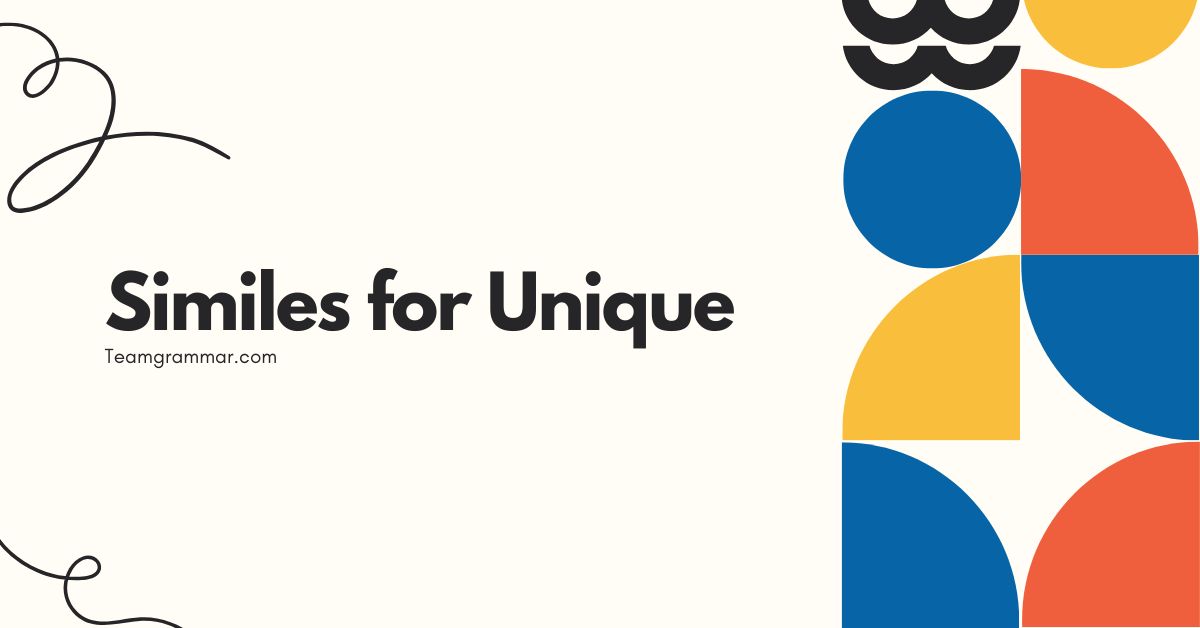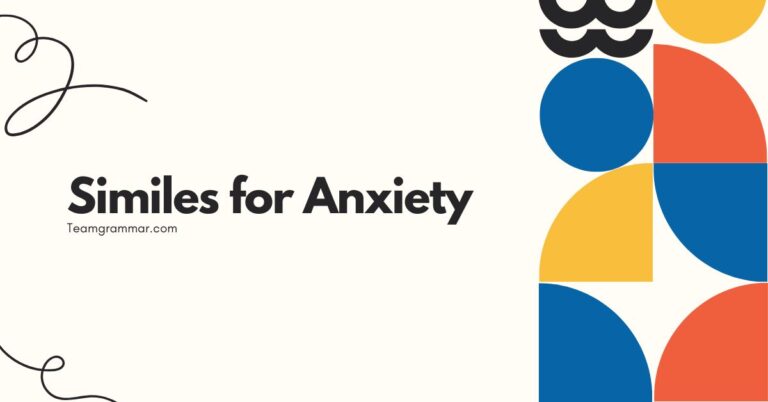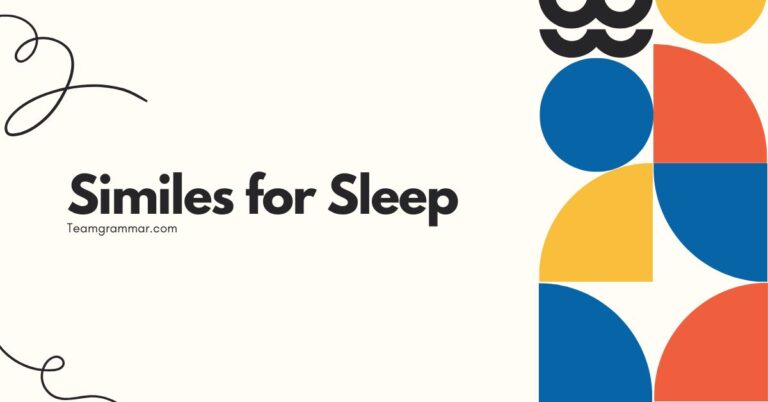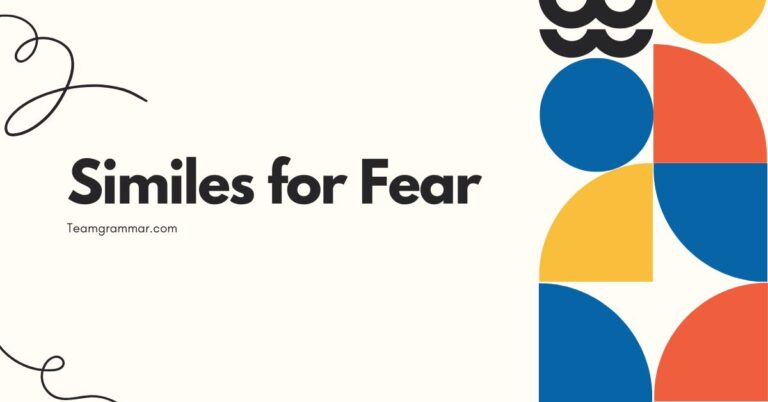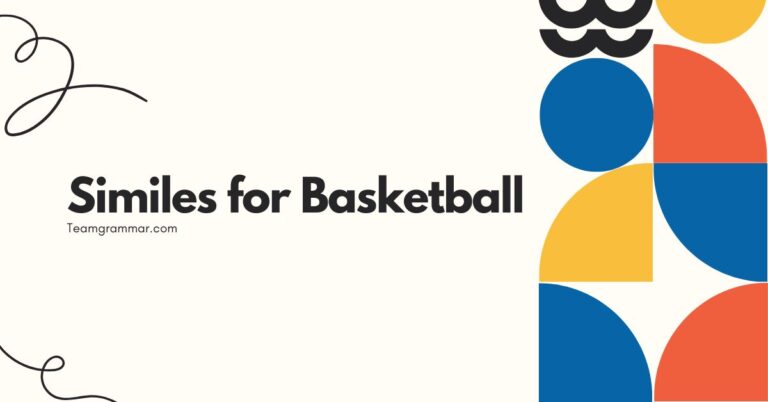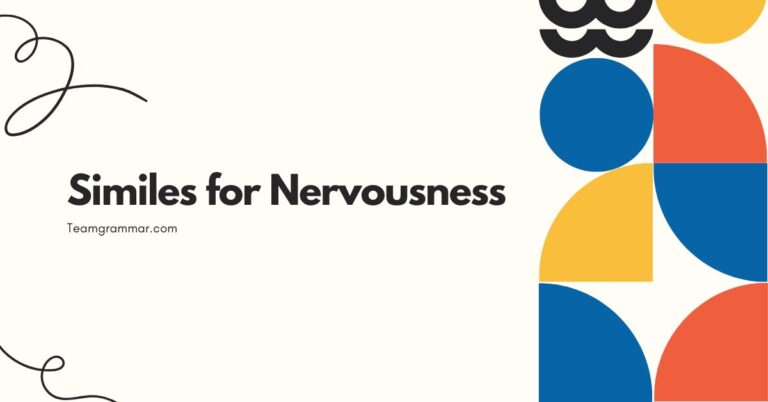39 Similes for Unique: Mastering Figurative Language
Understanding similes is crucial for enriching your writing and communication. Similes, a type of figurative language, allow you to draw comparisons between seemingly unrelated things, adding depth and color to your descriptions.
This article provides a comprehensive guide to using similes to describe uniqueness, covering definitions, structures, examples, usage rules, common mistakes, and practice exercises. Whether you’re a student, writer, or language enthusiast, this guide will help you master the art of using similes effectively to express the concept of being “unique.”
Table of Contents
- Introduction
- Definition of Simile
- Structural Breakdown of Similes
- Types of Similes Describing Uniqueness
- Examples of Similes for Unique
- Usage Rules for Similes
- Common Mistakes When Using Similes
- Practice Exercises
- Advanced Topics in Simile Usage
- FAQ: Frequently Asked Questions
- Conclusion
Introduction
Similes are powerful tools in the English language that allow us to create vivid and memorable descriptions. They work by comparing one thing to another using words like “like” or “as.” The concept of “unique” is often abstract, and similes can help make it more concrete and understandable.
This article will explore how to craft effective similes to describe uniqueness, enhancing your writing and communication skills.
By mastering the use of similes for describing uniqueness, you can add nuance and creativity to your language. This skill is particularly beneficial for writers, public speakers, and anyone who wants to express themselves more effectively.
Understanding the nuances of simile construction and usage will empower you to communicate your ideas with greater precision and impact.
Definition of Simile
A simile is a figure of speech that compares two unlike things using the words “like” or “as.” The purpose of a simile is to create a vivid image or to emphasize a particular quality of one of the things being compared. Similes are essential for adding color and depth to writing and speech, making abstract concepts more concrete and relatable.
Similes fall under the broader category of figurative language, which includes metaphors, personification, and hyperbole, among others. The key difference between a simile and a metaphor is that a simile explicitly uses “like” or “as” to make the comparison, while a metaphor implies the comparison without using these words.
The function of a simile is to enhance understanding and create a stronger impact on the reader or listener. By drawing a comparison to something familiar, a simile can make an unfamiliar or abstract concept more accessible.
In the context of describing uniqueness, similes can highlight the distinctiveness and exceptional nature of something or someone.
Structural Breakdown of Similes
The basic structure of a simile consists of three main components: the subject, the linking word (like or as), and the comparison. Understanding these components is crucial for constructing effective and meaningful similes.
Thesubjectis the thing being described or compared. It is the focus of the simile.
Thelinking word, either “like” or “as,” connects the subject to the comparison. Thecomparisonis the thing to which the subject is being compared.
It should share a common characteristic with the subject to make the simile meaningful.
For example, in the simile “He is as unique as a snowflake,” “He” is the subject, “as” is the linking word, and “a snowflake” is the comparison. The shared characteristic is the individuality and distinctiveness of each snowflake, which is used to emphasize the uniqueness of the subject.
The order of these components can sometimes be varied for stylistic effect, but the core structure remains the same. For instance, instead of saying “She is like a rare gem,” you could say “Like a rare gem, she shines.” The important thing is to maintain clarity and ensure that the comparison is easily understood.
Types of Similes Describing Uniqueness
Similes describing uniqueness can be categorized based on the type of comparison they make. These categories include comparisons to natural phenomena, rare objects, abstract concepts, and exceptional individuals.
Similes Comparing to Natural Phenomena
These similes draw comparisons to unique aspects of nature, such as snowflakes, stars, or rare geological formations. They emphasize the inherent distinctiveness found in the natural world.
Similes Comparing to Rare Objects
These similes compare the subject to rare or valuable items, such as precious gems, antique artifacts, or one-of-a-kind artworks. They highlight the rarity and preciousness of the subject.
Similes Comparing to Abstract Concepts
These similes compare the subject to abstract ideas like originality, individuality, or nonconformity. They emphasize the inherent qualities of uniqueness and distinctiveness.
Similes Comparing to Exceptional Individuals
These similes compare the subject to individuals known for their unique talents, achievements, or personalities. They highlight the exceptional nature of the subject by associating it with someone extraordinary.
Examples of Similes for Unique
This section provides a comprehensive collection of similes that can be used to describe uniqueness. The examples are categorized to help you find the most appropriate simile for your specific purpose.
Similes Highlighting Natural Uniqueness
These similes draw inspiration from the natural world to emphasize the distinctiveness of the subject. The examples below illustrate how natural phenomena can be used to convey the idea of uniqueness.
The table below provides a list of similes that compare uniqueness to aspects of nature. Each row describes a unique natural phenomenon, and how it is used in a simile to convey uniqueness.
| Simile | Explanation |
|---|---|
| As unique as a snowflake | Emphasizes the individuality of each snowflake. |
| Like a fingerprint, utterly unique | Highlights the distinct pattern of a fingerprint. |
| As rare as a blue moon | Refers to the infrequency of a blue moon event. |
| Like a one-of-a-kind seashell on the beach | Highlights the distinct form found on a beach. |
| As singular as a shooting star | Emphasizes the fleeting and distinct nature of a shooting star. |
| Like a rare orchid in a common garden | Highlights the distinct and precious nature of the orchid. |
| As unique as a geological formation | Emphasizes the distinct form of the geological formation. |
| Like a comet, appearing once in a lifetime | Highlights the distinct and precious nature of the comet. |
| As unique as the rings of Saturn | Emphasizes the distinct form of the rings. |
| Like a rare cloud formation | Highlights the distinct and precious nature of the cloud. |
| As unique as a desert bloom | Emphasizes the individuality of each desert bloom. |
| Like a rare mineral, utterly unique | Highlights the distinct pattern of a mineral. |
| As rare as a four-leaf clover | Refers to the infrequency of a four-leaf clover. |
| Like a one-of-a-kind gemstone in a mine | Highlights the distinct form found in a mine. |
| As singular as the aurora borealis | Emphasizes the fleeting and distinct nature of the aurora borealis. |
| Like a rare species in a common ecosystem | Highlights the distinct and precious nature of the species. |
| As unique as a river delta | Emphasizes the distinct form of the river delta. |
| Like a comet, never to be seen again | Highlights the distinct and precious nature of the comet. |
| As unique as the layers of the earth | Emphasizes the distinct form of the layers. |
| Like a rare snow crystal | Highlights the distinct and precious nature of the snow crystal. |
| As unique as a grain of sand | Emphasizes the individuality of each grain of sand. |
| Like a rare fossil, utterly unique | Highlights the distinct pattern of a fossil. |
| As rare as a solar eclipse | Refers to the infrequency of a solar eclipse. |
| Like a one-of-a-kind ripple in the ocean | Highlights the distinct form found in the ocean. |
| As singular as a volcanic eruption | Emphasizes the fleeting and distinct nature of a volcanic eruption. |
Similes Highlighting Rarity and Value
These similes compare the subject to rare and valuable objects, emphasizing their exceptional worth and scarcity. The examples below demonstrate how rare objects can be used to convey the idea of uniqueness.
The table below provides a list of similes that compare uniqueness to rare objects. Each row describes a unique object, and how it is used in a simile to convey uniqueness.
| Simile | Explanation |
|---|---|
| As rare as a vintage Stradivarius violin | Highlights the unique craftsmanship and value of the violin. |
| Like a priceless artifact, irreplaceable | Emphasizes the irreplaceable nature of the artifact. |
| As unique as a first edition novel | Refers to the rarity and value of a first edition. |
| Like a one-of-a-kind Fabergé egg | Highlights the intricate design and exclusivity of the egg. |
| As singular as a royal crown | Emphasizes the status and uniqueness of the crown. |
| Like a rare coin in a vast collection | Highlights the distinct and precious nature of the coin. |
| As unique as a lost masterpiece | Emphasizes the distinct form of the masterpiece. |
| Like a treasure, never to be replaced | Highlights the distinct and precious nature of the treasure. |
| As unique as the Hope Diamond | Emphasizes the distinct form of the diamond. |
| Like a rare stamp | Highlights the distinct and precious nature of the stamp. |
| As rare as a Gutenberg Bible | Highlights the unique craftsmanship and value of the Bible. |
| Like a priceless sculpture, irreplaceable | Emphasizes the irreplaceable nature of the sculpture. |
| As unique as an ancient manuscript | Refers to the rarity and value of an ancient manuscript. |
| Like a one-of-a-kind painting | Highlights the intricate design and exclusivity of the painting. |
| As singular as a royal scepter | Emphasizes the status and uniqueness of the scepter. |
| Like a rare pearl in an oyster | Highlights the distinct and precious nature of the pearl. |
| As unique as a lost gold mine | Emphasizes the distinct form of the gold mine. |
| Like a treasure, never to be found again | Highlights the distinct and precious nature of the treasure. |
| As unique as the Koh-i-Noor Diamond | Emphasizes the distinct form of the diamond. |
| Like a rare tapestry | Highlights the distinct and precious nature of the tapestry. |
| As rare as a signed Beatles record | Highlights the unique craftsmanship and value of the record. |
| Like a priceless royal jewel, irreplaceable | Emphasizes the irreplaceable nature of the jewel. |
| As unique as a hand written letter from Leonardo Da Vinci | Refers to the rarity and value of a letter. |
| Like a one-of-a-kind car | Highlights the intricate design and exclusivity of the car. |
| As singular as a pharaoh’s burial mask | Emphasizes the status and uniqueness of the mask. |
Similes Highlighting Abstract Uniqueness
These similes draw comparisons to abstract concepts that embody uniqueness, such as originality, individuality, and nonconformity. The examples below illustrate how abstract ideas can be used to convey the idea of uniqueness.
The table below provides a list of similes that compare uniqueness to abstract concepts. Each row describes a unique concept, and how it is used in a simile to convey uniqueness.
| Simile | Explanation |
|---|---|
| As unique as a truly original idea | Emphasizes the rarity and value of an original thought. |
| Like a beacon of individuality, unmatched | Highlights the unmatched nature of individuality. |
| As unique as a nonconformist’s spirit | Refers to the rarity and value of a nonconformist spirit. |
| Like a one-of-a-kind perspective | Highlights the intricate design and exclusivity of the prespective. |
| As singular as a revolutionary concept | Emphasizes the status and uniqueness of the concept. |
| Like a rare spark of genius | Highlights the distinct and precious nature of the genius. |
| As unique as a pioneering invention | Emphasizes the distinct form of the invention. |
| Like a treasure of innovation, unmatched | Highlights the distinct and precious nature of the innovation. |
| As unique as a creative vision | Emphasizes the distinct form of the vision. |
| Like a rare dream | Highlights the distinct and precious nature of the dream. |
| As unique as a truly original piece of art | Emphasizes the rarity and value of an original idea. |
| Like a beacon of creativity, unmatched | Highlights the unmatched nature of creativity. |
| As unique as a visionary’s spirit | Refers to the rarity and value of a visionary’s spirit. |
| Like a one-of-a-kind approach | Highlights the intricate design and exclusivity of the approach. |
| As singular as a paradigm shift | Emphasizes the status and uniqueness of the shift. |
| Like a rare burst of inspiration | Highlights the distinct and precious nature of the inspiration. |
| As unique as a breakthrough discovery | Emphasizes the distinct form of the discovery. |
| Like a treasure of originality, unmatched | Highlights the distinct and precious nature of the originality. |
| As unique as a profound insight | Emphasizes the distinct form of the insight. |
| Like a rare moment of clarity | Highlights the distinct and precious nature of the clarity. |
| As unique as a truly original style | Emphasizes the rarity and value of an original idea. |
| Like a beacon of innovation, unmatched | Highlights the unmatched nature of innovation. |
| As unique as a maverick’s spirit | Refers to the rarity and value of a maverick’s spirit. |
| Like a one-of-a-kind creation | Highlights the intricate design and exclusivity of the creation. |
| As singular as a game changing strategy | Emphasizes the status and uniqueness of the strategy. |
Usage Rules for Similes
Using similes effectively requires adherence to certain rules and guidelines. These rules ensure that your similes are clear, meaningful, and impactful.
It’s important to consider the context, audience, and purpose of your writing when choosing and crafting similes.
Clarityis paramount. The comparison should be easily understood by the reader or listener.
Avoid using obscure or overly complex comparisons that may confuse your audience. The relationship between the subject and the comparison should be evident.
Relevanceis also crucial. The comparison should be relevant to the subject and should highlight a specific quality or characteristic that you want to emphasize.
Avoid using comparisons that are arbitrary or unrelated to the subject.
Originalitycan make your similes more memorable and impactful. Try to avoid clichés and overused comparisons.
Instead, strive to create fresh and imaginative similes that will capture your audience’s attention. However, be careful not to be so original that your simile becomes confusing or nonsensical.
Consistencyin tone and style is also important. Your similes should be consistent with the overall tone and style of your writing.
Avoid using similes that clash with the rest of your text.
Common Mistakes When Using Similes
Even experienced writers can make mistakes when using similes. Being aware of these common errors can help you avoid them and improve the quality of your writing.
Using clichésis one of the most common mistakes. Clichés are overused comparisons that have lost their impact and originality.
Examples include “as busy as a bee” or “as strong as an ox.” While clichés may be easily understood, they lack creativity and can make your writing seem uninspired.
Creating mixed metaphorsis another common error. A mixed metaphor occurs when you combine two or more unrelated metaphors or similes in a way that creates a confusing or nonsensical image.
For example, “He was burning the midnight oil at both ends” is a mixed metaphor that doesn’t make logical sense.
Using illogical comparisonscan also detract from the effectiveness of your similes. The comparison should be based on a shared characteristic between the subject and the comparison.
Avoid using comparisons that are arbitrary or unrelated.
Being overly complexcan confuse your audience. The simile should be clear and easily understood.
Avoid using obscure or overly complex comparisons that may require your audience to expend unnecessary effort to understand your meaning.
Here are some examples of common mistakes and their corrections:
| Incorrect | Correct | Explanation |
|---|---|---|
| He was as busy as a bee. | He was as busy as a one-man band. | Avoid clichés; use a more original comparison. |
| She was burning the midnight oil at both ends. | She was working tirelessly through the night. | Avoid mixed metaphors; use a clear and logical comparison. |
| The idea was as heavy as a feather. | The idea was as light as a feather. | Avoid illogical comparisons; ensure the comparison makes sense. |
| His explanation was as complex as the universe itself, wrapped in a riddle, hidden in an enigma. | His explanation was as complex as the universe itself. | Avoid being overly complex; keep the comparison concise and understandable. |
Practice Exercises
These exercises will help you practice using similes to describe uniqueness. Each exercise focuses on a different aspect of simile construction and usage.
Work through the exercises carefully and check your answers against the provided solutions.
Exercise 1: Identifying Similes
Identify the similes in the following sentences:
| Question | Answer |
|---|---|
| 1. Her talent was like a rare gem, shining brightly. | like a rare gem |
| 2. He stood out as unique. | (No simile present) |
| 3. The artist’s style was as unique as a fingerprint. | as unique as a fingerprint |
| 4. The solution was innovative. | (No simile present) |
| 5. His perspective was like looking through a kaleidoscope. | like looking through a kaleidoscope |
| 6. Her voice was as unique as a songbird’s melody. | as unique as a songbird’s melody |
| 7. The invention was revolutionary. | (No simile present) |
| 8. His approach was as unique as a snowflake. | as unique as a snowflake |
| 9. The design was creative. | (No simile present) |
| 10. Her ideas were like stars in the night sky. | like stars in the night sky |
Exercise 2: Completing Similes
Complete the following similes with an appropriate comparison:
| Question | Answer |
|---|---|
| 1. His talent was as unique as __________. | a rare orchid |
| 2. Her style was like __________. | a one-of-a-kind painting |
| 3. The invention was as unique as __________. | a pioneering discovery |
| 4. His perspective was like __________. | looking through a prism |
| 5. Her voice was as unique as __________. | a rare instrument |
| 6. The idea was as unique as __________. | a truly original concept |
| 7. The approach was like __________. | a revolutionary strategy |
| 8. The creation was as unique as __________. | a masterpiece |
| 9. The solution was like __________. | a stroke of genius |
| 10. The performance was as unique as __________. | a comet sighting |
Exercise 3: Writing Similes
Write a simile to describe the uniqueness of each of the following:
| Question | Answer |
|---|---|
| 1. A unique piece of art | The piece of art was as unique as a lost masterpiece. |
| 2. A unique personality | Her personality was like a rare flower in a common garden. |
| 3. A unique idea | The idea was as unique as a revolutionary concept. |
| 4. A unique invention | The invention was like a pioneering discovery, unmatched in its field. |
| 5. A unique voice | His voice was as unique as a rare instrument, captivating all who listened. |
| 6. A unique style | Her style was as unique as a snowflake, with no two outfits ever alike. |
| 7. A unique approach | Their approach was like a revolutionary strategy, changing the game entirely. |
| 8. A unique solution | The solution was as unique as a flash of inspiration, solving the problem in an instant. |
| 9. A unique talent | Her talent was as unique as a vintage Stradivarius violin, producing unparalleled melodies. |
| 10. A unique perspective | His perspective was like looking through a kaleidoscope, revealing beauty in every angle. |
Advanced Topics in Simile Usage
For advanced learners, exploring more nuanced aspects of simile usage can further enhance their writing and communication skills. These topics include the use of extended similes, the combination of similes with other figures of speech, and the adaptation of similes for different contexts and audiences.
Extended similesinvolve developing a comparison over several sentences or even paragraphs. This allows for a more detailed and nuanced exploration of the relationship between the subject and the comparison.
Extended similes can be particularly effective for creating vivid imagery and conveying complex ideas.
Combining similes with other figures of speech can add depth and complexity to your writing. For example, you could combine a simile with personification to create a more engaging and imaginative description.
Adapting similes for different contexts and audiencesis essential for effective communication. Consider your audience’s background, knowledge, and expectations when choosing and crafting similes.
A simile that is appropriate for one audience may not be appropriate for another.
FAQ: Frequently Asked Questions
This section addresses some frequently asked questions about using similes to describe uniqueness.
- What is the difference between a simile and a metaphor?
A simile explicitly compares two things using “like” or “as,” while a metaphor implies the comparison without using these words. For example, “He is like a lion” is a simile, while “He is a lion” is a metaphor.
- How can I avoid using clichés in my similes?
To avoid clichés, try to think of fresh and original comparisons that are not commonly used. Brainstorm different associations and connections that you can make between the subject and other things.
- What makes a simile effective?
An effective simile is clear, relevant, and original. It should be easily understood by the audience, highlight a specific quality of the subject, and avoid overused comparisons.
- Can a simile be too complex?
Yes, a simile can be too complex if it is difficult for the audience to understand. The comparison should be relatively straightforward and should not require specialized knowledge or excessive mental effort.
- How important is it to use similes in writing?
While not essential, similes can greatly enhance your writing by adding color, depth, and impact. They can make your descriptions more vivid and memorable, and they can help you convey complex ideas in a more accessible way.
- Are there any situations where I should avoid using similes?
In some formal or technical writing, similes may be inappropriate if they detract from the objectivity and precision of the text. In these cases, it may be better to use more direct and literal language.
- How can I improve my ability to create effective similes?
Practice is key. Pay attention to the similes that you encounter in your reading and listening, and try to analyze why they are effective. Experiment with different comparisons and ask for feedback from others.
- Is it okay to use humor in similes?
Yes, humor can be an effective element in similes, making them more memorable and engaging. However, be careful to use humor appropriately and avoid being offensive or insensitive.
- How can I tell if a simile is relevant?
A simile is relevant if the comparison highlights a specific quality or characteristic of the subject that you want to emphasize. The relationship between the subject and the comparison should be meaningful and should contribute to the overall message.
- Can I combine similes with other literary devices?
Yes, combining similes with other literary devices like personification, metaphor, or hyperbole can create richer and more complex imagery. This will add depth to your writing and enhance its impact.
Conclusion
Mastering the use of similes is a valuable skill for anyone who wants to improve their writing and communication. By understanding the structure, types, and usage rules of similes, you can craft effective comparisons that add depth, color, and impact to your language.
Remember to focus on clarity, relevance, and originality when creating similes to describe uniqueness.
Practice is essential for developing your ability to use similes effectively. Pay attention to the similes that you encounter in your reading and listening, and experiment with different comparisons to find what works best for you.
With consistent effort, you can become a skilled user of similes and enhance your ability to express yourself in a creative and meaningful way. Don’t be afraid to explore and experiment with different similes to find your unique voice and style in writing.

